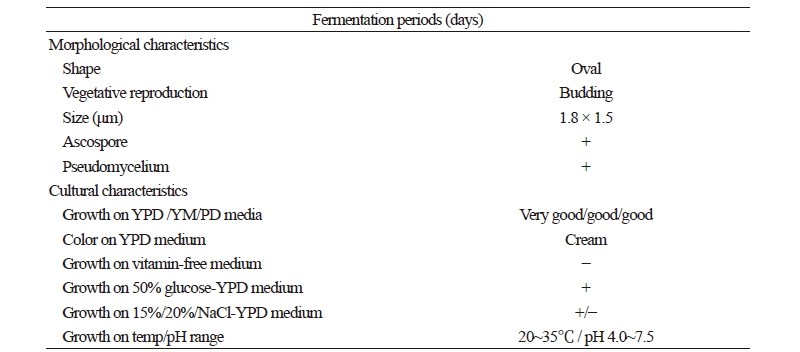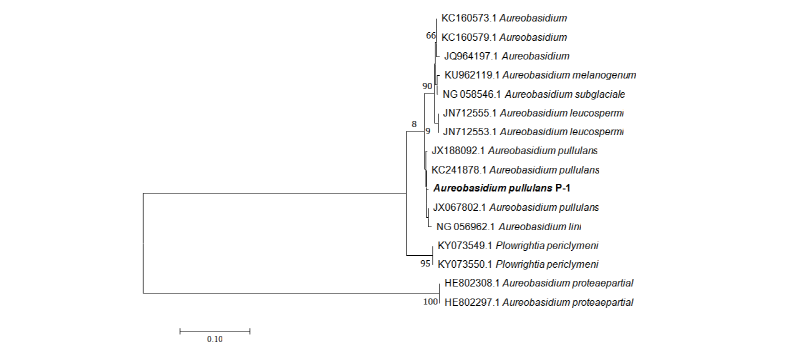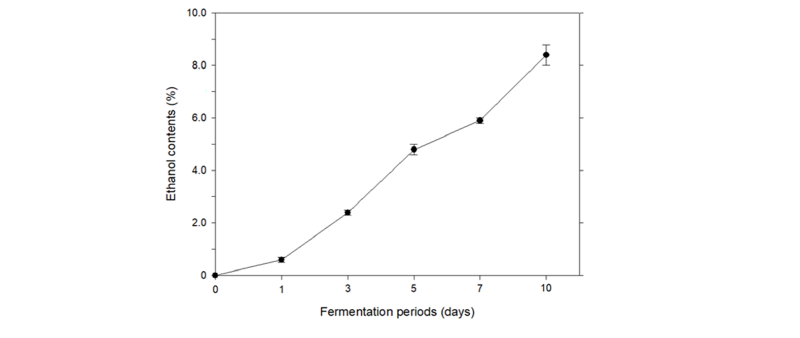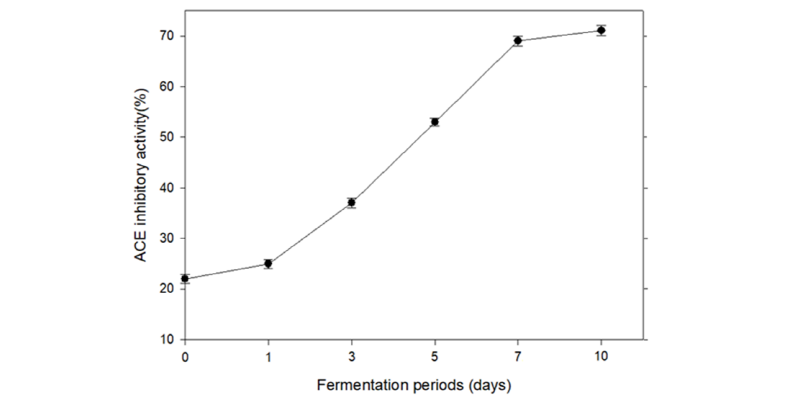서론
효모는 자낭포자와 일부 담자포자를 생성하는 유포자 효모와 무포자 효모로 구별되는 진균류로서 오래 전부터 주류와 빵 등의 식품산업과 비타민 등의 약용물질 생산 등에 이용되어 왔고 최근에는 이들을 이용한 산업용 효소제와 몇 가지 생리기능성 물질 생산 등이 보고되었다[1, 2]. 또한 학술적으로는 특정 대사산물의 생성, 분비와 유전자 발현 기작을 해석하는 분자생물학적 연구 도구로도 이용되고 있다[1].
지금까지 효모는 주로 전통발효식품이나 이들의 주, 부원료들에서 분리되었고 최근 필자 등은 한라산 등의 우리나라 주요 산들과 제주도, 울릉도, 선유도 등의 섬 및 대전광역시 등의 도시와 농촌 지역 등의 야생화들과 토양 등지에서 약 1,700여종의 야생 효모들을 분리한 후 분자계통분류학적 방법 등으로 동정하여 보고 하였다[3-11]. 또한 이들 중에서 아직까지 국내에서 보고되지 않은 미기록 야생 효모들을 선별한 후 이들의 미생물학적 특징들을 조사하여 보고하였고[12-14], 이들 중 비병원성 효모들에 대하여 건강소재 개발을 위한 생리기능성을 조사하여 보고하였다[4, 7, 8, 15, 16].
한편, 막걸리는 병행복발효 형식으로 제조되는 전통주로서 우리나라 사람들이 오래 전부터 즐겨 마시는 술이다. 2000년대 초반, 막걸리에 항고혈압 활성물질과 면역성 베타 글루칸, 비만 예방의 식이섬유 등이 함유되어 있고, 장내 유용 유산균을 막걸리 700 mL에 약 700~800억 CFU를 함유하고 있으며[17, 18], 암세포 성장을 억제하는 파네졸을 함유하고 있다고 알려지면서 한때 그 수요가 크게 증가하였다.
그러나, 막걸리 고유의 향미 부재와 독창성이 적은 막걸리 제품들의 범람 등으로 현재 막걸리 수요는 답보 상태에 있다. 따라서, 다양한 특징적 향미를 가지면서 유용한 생리 활성물질을 함유한 새로운 막걸리의 개발이 요구되며 이를 위해서 우선 막걸리 제조용 우량 효모 개발 연구가 선행되어야만 한다.
따라서 본 연구에서는 야생 효모를 이용한 새로운 고품질 막걸리를 개발하고자 먼저 충남 예당 저수지 주위 야생화들에서 분리한 비병원성 야생 효모들 중 알코올 발효능이 우수했던 Aureobasidium pullulans P-1을 선발하여 이들의 균학적 특성을 조사하였고 이 균을 주모로 이용하여 막걸리를 발효시키면서 이들의 품질 특성 변화를 조사하여 막걸리 최적 발효일수를 확립하였다.
재료 및 방법
발효제 및 주모
S 막걸리공장에서 제조한 입국(산도: 9.32, 당화력: 141 sp)을 당화효소 생성용 발효제로 사용하였다. 또한 배재대학교 생물공학연구실에서 충남 예당 저수지의 야생화에서 분리한 비병원성 야생 효모들 중 알코올 발효 우수 효모로 선발한 A. pullulans P-1을 yeast extract-peptone-dextrose (YPD) 배지에 접종 후 27℃에서 2일 배양하여 주모로 사용하였다.
막걸리 제조
실험실에서의 선발 균주를 이용한 최적 발효일수를 확립하기 위하여 증자미 100 g, 입국 30 g, 물 180 mL를 혼합하여 술밑을 제조한 후 A. pullulans P-1로 제조한 주모를 5% 첨가하여 25℃에서 단 담금 한 후 1~10일 발효시키면서 발효 1일, 3일, 5일, 7일, 10일 후 각각의 발효액들을 여과하여 시료용 막걸리로 하였다[19].
에탄올 함량은 알코올 자동분석기(Alcolyzer; Anton Paar, Graz, Austria)를 이용하여 측정하였고 pH는 pH meter (Orion Star A211; Thermo Fisher Scientific, Waltham, MA, USA)를 사용하여 측정하였다. 총산(적정산도)은 시료 10 mL를 0.1 N NaOH 용액으로 중화 적정한 후 소비 mL를 이용하여 초산으로 환산하였고 휘발산은 수증기 증류액을 총산 측정법과 같이 측정하였으며 잔당은 DNS법으로 정량 하였다[19].
효모 생균수 측정
시료 막걸리 1 mL을 멸균한 생리 식염수에 10진 희석법에 따라 희석하고 희석된 시료 200 μL를 yeast extract-malt extract (YM) 한천배지에 접종 후 30℃에서 48시간 배양하여 효모 생균수들을 계수하였다[20].
안지오텐신 전환효소 저해활성 측정
항고혈압성 안지오텐신 전환효소(angiotensin I-converting enzyme, ACE) 저해활성은 먼저 막걸리 시료액에 동일 용량의 ethyl acetate를 첨가하여 12시간 진탕하여 얻은 추출액 50 μL를 rabbit lung powder에서 추출한 ACE 용액 150 μL (3 unit)와 기질 용액(pH 8.3의 100 mM sodium borate buffer 2.5 mL에 300 mM NaCl과 25 mg Hip-His-Leu을 용해) 50 μL와 섞은 후 37℃에서 30분간 반응시킨 다음 1 N HCl로 반응을 정지시켰다. 이 반응액에 유리되어 나오는 hippuric acid 함량을 228 nm에서 흡광도를 측정하여 정량하였고 시료 무첨가구를 대조구로 하여 아래와 같이 저해율을 산출하였다[18].
ACE 저해활성(%) = {1 − (T(시료구) − T.B(시료구blank)/C(대조구) − B(대조구blank))} × 100
결과 및 고찰
알코올 발효성
알코올 발효성
알코올 발효성
필자 등이 충남 예당 저수지 부근 야생화에서 분리한 야생 효모들 중 알코올 발효성 우수 효모로 최종 선발한 A. pullulans P-1의 주요 균학적 특성과 DNA 염기서열에 기초한 계통수는 각각 Table 1, Fig. 1과 같다.
|
Table 1. Microbiological characteristics of the selected alcohol-fermenting Aureobasidium pullulans P-1 
|
|
|
YPD, yeast extract-peptone-dextrose; YM, yeast extract-malt extract; PD, potato-dextrose. |
|
A. pullulans P-1는 구형으로 출아에 의해 영양증식을 하였고 자낭포자와 의균사를 형성하였으며 vitamin-free 배지에서 생육하지 못했다. 특히 50% 포도당 함유 YPD 배지와 15% NaCl를 함유한 YPD 배지에서도 생육하는 내당성이면서 호염성인 효모이었고 20%의 에탄올을 함유한 배지에서도 생육하는 고농도 알콜 내성 효모이었다.
A. pullulans은 Deniatium pullulans 또는 Pullularia pullulans로 알려진 효모로서 주로 토양이나 과일, 양조장 주변의 토양이나 부식물 등에서 많이 분리되었고, A. pullulans를 이용한 항생물질과 글루콘산, 식품 포장용 pullulan 생산, 포도 식물병 방제와 일부 곰팡이 독성 물질인 ochratoxin의 경감 등이 보고 되었다[21]. 그러나 아직까지 이 균을 이용한 에탄올 생산 연구는 보고되지 않았고 특히 이 균이 알코올 발효성 외에도 내당성 등이 강하여 이 균을 이용한 고농도 에탄올 생산에도 크게 유용할 것으로 생각되어 이에 관한 추가의 연구가 필요해 보인다.
막걸리 발효 중의 이화학적 성질과 효모 생균 수의 변화
알코올 발효성 야생 효모, A. pullulans P-1를 이용한 막걸리 최적 발효일수를 조사하기 위하여 시험효모의 배양액을 주모로 증자미와 입국과 물이 혼합된 술밑에 5% 첨가하여 단담금 한 후 25℃에서 1~10일간 발효시키면서 발효 중의 이화학적 성질의 변화를 조사한 결과는 Table 2, Fig. 2와 같다.
pH는 발효 시작 4.43에서 발효 5일에 3.71로 낮아진 후 변화가 거의 없었고 총산 함량은 발효 7일까지 0.42%에서 0.68%까지 증가하였다. 잔당 함량은 발효 초기인 발효 3일까지 0.60 mg/mL으로 증가한 후 에탄올 생성이 왕성했던 발효 10일에는 0.41 mg/mL로 낮아졌다. 에탄올 함량은 당 함량이 증가하는 발효 3일 후부터 서서히 증가하기 시작하여 발효 10일에 가장 많은 8.45%가 생성되었다(Fig. 2). 한편 효모 생균수는 에탄올이 본격적으로 생산되기 시작하는 발효 5일에 7 × 107 CFU/mL로 가장 높았다(Fig. 3).
항고혈압성 안지오텐신 전환효소 저해활성
쌀을 주 원료로 제조되는 전통주들의 ACE 저해활성이 높았다는 필자의 보고들[17, 18]을 참고하여 본 연구에서 선발된 A. pullulans P-1을 이용한 막걸리 발효기간에 따른 항고혈압성 ACE 저해활성의 변화를 조사한 결과는 Fig. 4와 같다. 발효가 진행됨에 따라 이들 저해활성이 증가하여 발효 7일후의 막걸리들에서 71.1 ± 0.3%로 최대를 보인 후 변화가 없었다.
비록, 이러한 ACE 저해활성이 Kim 등[22]의 시판 생 쌀막걸리인 EDS-14와 YN-HM6의 ACE 저해활성(89.0%, 89.9%)보다는 약간 낮은 활성이었지만 Min 등[17]의 시판 생 막걸리 R-12의 저해활성(73.7%)과는 비슷하였고 따라서 본 연구에서 제조된 막걸리는 건강 주류로서 비교적 우수한 ACE 저해활성으로 앞으로 막걸리 품질의 고급화 측면에서 산업적 응용성이 있을 것으로 추정된다.
이상의 결과들을 종합했을 때 야생 효모인 A. pullulans P-1 균주를 이용한 막걸리 발효 최적 조건은 주모 첨가량 5%, 발효온도 25℃, 발효 최적 일수는 10일이었다.
지금까지 각종 주류 제조용 알코올 발효 효모로는 Saccharomyces cerevisiae가 이미 오래 전부터 사용되고 있으나[23-26], 본 연구에서 새롭게 선별된 알코올 발효성 야생 효모인 A. pullulans P-1는 비 Saccharomyces속 균으로 학술적으로 이 균의 에탄올 생성 기작을 밝히는 연구에 귀중한 균주로 활용될 것이고 이들의 내당성과 에탄올 내성 등을 이용하여 고농도 담금을 통한 에탄올 대량 생산에 매우 유용한 균주로 활용이 기대된다.
적요
본 연구는 알코올 발효능이 우수한 야생 효모를 막걸리 발효에 응용할 목적으로 충남 예산군 예당 저수지 야생화에서 분리한 비병원성 야생 효모들 중 에탄올 생산 우수 효모로 선발한 Aureobasidium pullulans P-1의 균학적 특성과 막걸리 발효 조건을 조사하였다. A. pullulans P-1는 출아에 의해 영양증식을 하였고 자낭포자를 생성하는 유포자 효모로서 내당성과 에탄올 내성이 강한 호염성 야생 효모이었다. A. pullulans P-1의 yeast extract-peptone-dextrose 배양액을 주모로 증자미와 입국과 물이 혼합된 술밑에 5% 첨가한 후 25℃에서 1~10일간 발효시키면서 발효 중의 이화학적 성질의 변화를 조사한 결과, 에탄올 함량은 25℃로 10일간 발효시켰을 때 가장 많은 8.45%를 생성하였고 관능 특성이 우수하였으며 항고혈압 활성 안지오텐신 전환효소 저해활성이 71.1%로 높았다.






